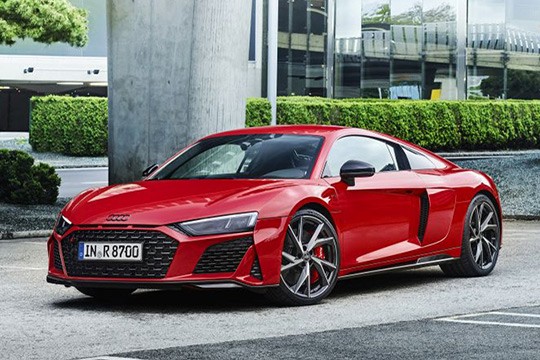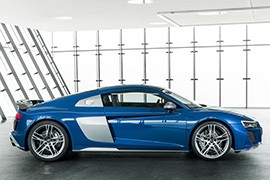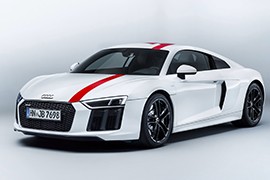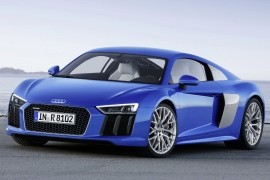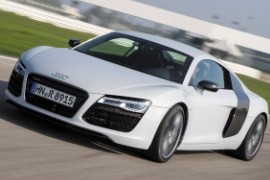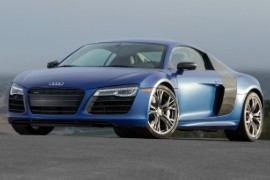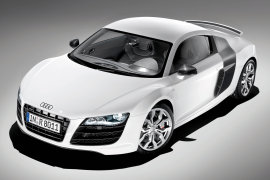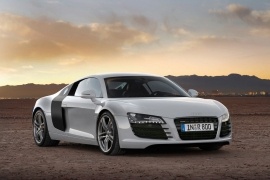AUDI R8 Models/Series Timeline, Specifications & Photos
First production year: 2007
Engines: Gasoline, Electric
Body style: Coupé (two-door)
While Audi was mostly known for its quattro all-wheel drive system that it promoted since the early '80s, in 2021, it offered the R8 V10 Performance as a rear-wheel drive affair.
In 2017, Audi introduced a limited edition of its R8 V10 supercar, the RWS. Unlike the rest of the range, it was a rear-wheel drive only version, which thrilled its customers. Since it didn't have a front differential at the front and the entire car was lighter than its quattro siblings, drivers could have more fun in that. But Audi made just 999 units of the coupe and the same number for the Spyder version. All of them sold like hotcakes, and customers craving one were left with tears in their eyes. But that didn't last too long since after the car manufacturer introduced the facelift for the R8, it also brought a special version named R8 V10 Performance, which was a rear-wheel drive. Those who couldn't get the 2017 RWS version could enjoy the moment. The new version was more powerful and better equipped to handle a race track than its 2WD predecessor.
When Audi refreshed the second generation of the R8 V10, it slightly upgraded the car's front. The massive singleframe grille sported a honeycomb mesh pattern finished in matte black. The automaker used the same shade for the side scoops' grilles that cooled the front brakes. Another specific detail of the car was the three slits at the lower part of the hood, a reminiscent detail carried over from the Ur-Quattro from the early '80s.
From its profile, the R8 V10 Performance had the same shape as its quattro siblings, sporting black or satin finish door mirror caps, depending on the color options chosen by the customers. Audi also offered them the choice of getting the air intakes in body color, black or satin silver. The wheels' design was also unique for this version. Finally, at the back, customers could get the car with either a broad matte black grille resembling the Ur-Quattro one or a body-colored panel in the middle, between the vents that released the air trapped in the rear wheels' wells. Furthermore, a set of big and round pipes poked through the lower part of the bumper, flanking the diffuser.
Inside, the cabin was fitted with slim sports seats with integrated headrests. The driver fronted a flat-bottom steering wheel that sported several buttons and switches, including the one for the start/stop engine painted in red. An aluminum plaque with the RWD lettering on it adorned the dashboard in front of the passenger.
But the most important part of the vehicle was its drivetrain. The 5.2-liter V10 engine produced 570 PS (562 hp) and sent to the rear wheels via a seven-speed automatic (dual-clutch) gearbox. The car was lighter by 65 kilograms (143 lbs.) than its quattro sibling. Furthermore, the car's adaptive suspension and electromechanical steering helped drivers get faster laps around a race track and also obtained controlled drifts. Last but not least, it was fitted as standard with ceramic brakes.
Audi refreshed the second generation of the R8 V10 supercar in late 2018, and besides some exterior changes, it also upgraded its suspension and the drivetrain for an even more thrilling experience.
With over 30,000 units sold during the two generations of the R8 since the model’s introduction in 2006, the German supercar was a great success. In 2015, the automaker unveiled the model’s second generation at the Geneva Motor Show. This time, it offered it as a V10-only affair. But Audi wanted to keep the sales momentum. In 2018, it gave the car a well-deserved facelift that primarily affected the exterior and the drivetrain. The car became so desirable that when Audi announced it would end production in 2023, orders started to pile up. Hence, the automaker had to keep the assembly lines working until spring 2024.
At the front, Audi installed a new honeycomb mesh grille that was wider and flatter than before. It was flanked by LED headlights with L-shaped daytime running lights on their outer upper corners. Below them, the automaker placed the redesigned air intakes that cooled the front brakes and created an air curtain around the bodywork. On the non-facelifted version, the R8 V10 featured two vertical slats, which were removed for the 2018 model year.
From its profile, there were minor changes, which mostly only the models’ fans could notice. For instance, the car sported black V10 badges placed on the front fenders instead of the chromed ones used before. In addition, the door mirror caps were silver, in the Audi Sport fashion. Moving on to the sides, the silver air intakes placed behind the rear doors replaced the black ones used in the 2015 model year. Surprisingly, the most significant changes were on the car’s rear side. It was like a statement that said that that was the most commonly viewed part of the vehicle. There was a broad grille from side to side. The taillights were also new, and under the bumper, the car manufacturer installed two big round exhausts, one on each side. Another interesting detail was in the engine bay behind the cabin. Audi installed a set of LEDs on the sides, which could illuminate the big V10 powerplant installed there.
The cabin was mostly the same, featuring a flat-bottom steering wheel that housed the buttons for the start/stop, the active exhausts, and the drive mode selector. The sports seats were divided by the center console that could be finished in a dark carbon fiber trim, which was not available on the non-facelifted version.
The 5.2-liter V10 powerplant carried over from Lamborghini was available in a few power versions, the most potent one sending 640 PS (633 hp) to the wheels via a seven-speed automatic (dual-clutch) S-Tronic gearbox. The quattro all-wheel drive system was standard.
In 2017, Audi revealed the most surprising version of its R8 V10 supercar, which featured a rear-wheel drive instead of its usual quattro all-wheel drive system.
When Audi launched the R8 in 2006, the car was available with the quattro all-wheel drive system. The automaker used that system again when it introduced the second generation of this nameplate in 2015. But then, Audi wanted something different. As a result, in 2017, it unveiled a 999-unit limited edition of the R8 V10 with a rear-wheel drive system only. And that’s where the RWS nameplate came from.
An untrained eye couldn’t distinguish between the R8 RWS and an R8 V10 Plus. They both had the same front fascia with that honeycomb mesh grille wide enough to cover the area between the headlights. But instead of sporting a quattro badge on it, Audi installed an “Audi Sport” one. It was tiny, mounted in the upper left corner. The same honeycomb mesh that filled the main grille adorned the side scoops. Unlike its stablemates, on the R8 RWS, these decorations sported a matte black finish instead of a shiny one.
From its profile, there were a few subtle changes for the R8 RWS compared to the regular R8 V10. While both sported the V10 chromed badges on the front fenders, the RWS body-colored door mirrors instead of black. The same shade of the vehicle was applied to the air intakes mounted behind the doors, while on the R8 V10 or the R8 V10 Plus, those were black. These were tiny details that Audi wanted its fans to discover. Finally, at the back, the automaker placed matte black honeycomb mesh grilles on the rear vents that released the air trapped in the wheel wells. On the lower side of the bumper, the automaker installed a massive diffuser flanked by a pair of rectangular exhausts with a chromed finish. Those were the only shiny elements mounted on the car’s exterior. Every other trim was black.
Inside, Audi installed a pair of sports seats with Alcantara interior and Nappa outer sides. The integrated headrests were part of the package. Between occupants, the automaker installed the center console that housed the automatic transmission lever and the rotary dial for Audi’s MMI multimedia system. Surprisingly, it didn’t use carbon fiber trims for the center console, dashboard, or door panels, like in the R8 V10 Plus. It was just a high-quality plastic. The driver fronted a flat-bottom steering wheel where the red start-stop button was mounted. In addition, a rotary dial placed on the left side of the lower spoke helped the driver select the driving mode.
Under the hood was the same 5.2-liter naturally aspirated V10 that powered the rest of the range. It produced 540 PS (533 hp) that it sent to the rear wheels via a seven-speed S-Tronic automatic (dual-clutch) gearbox. Since the car lacked the front differential, it was lighter than its siblings and made for purists. It was for those who craved a classic RWD supercar.
Three years after introducing a facelift for the R8’s first generation, Audi surprised its customers with the launch of the second sequel of this nameplate, and in 2015, it came fully prepared to face the supercar arena.
After claiming the same number of victories on the notorious 24 Hours of Le Mans race as Ford and Ferrari combined, falling short just behind Porsche, Audi considered that it deserved a seat at the supercar manufacturers table. Furthermore, it demanded one closer to the one that sat on one end. After all, it had thirteen gold medals at the famous French endurance race. To celebrate this, it pushed its engineers to work on the second generation of the R8 and make it better than anyone could hope from the four-rings badged brand, which they did. But first, they had to retire the 4.2-liter V8 powerplant. As a result, the second generation of the R8 came as a V10-powered affair only.
The era of bio-design influence was gone when the German car manufacturer started to work on the R8’s second generation. As a result, the 2015 model came with sharp-looking lines for the headlights and distinct daytime running lights that emphasized the upper outer corners of them. In the middle of the bumper, the R8 featured an angular-shaped singleframe grille with distinct outer corners. It was flanked by rectangular scoops that featured vertical slats to cool the front rotors. To emphasize the new generation, the car sported two creases on the hood that visually connected the headlights to the windshield.
From its sides, the car’s profile revealed its mid-engined configuration. The short nose was followed by a low-slung greenhouse with a rounded roof and sloped down at the back. Unlike its predecessor, the second generation of the R8 sported shorter side panels with contrasting colors for the air intakes placed behind the doors. The sculptured doors had the handles concealed under the upper crease, so it wouldn’t spoil the car’s overall look. Finally, the back of the car sported the sharp-angled taillights, which were neatly integrated with the design of the exhaust vents placed below them. A fixed-wing adorned the rear deck, confirming the car’s sports-oriented profile if anyone doubts that. Finally, on the lower part of the bumper, the automaker installed a diffuser flanked by rectangular-shaped exhausts.
Inside, Audi installed a luxurious and comfortable cabin fitted with leather-covered sports seats. On the center console between them, the automaker placed the gear selector, the rotary controller for the MMI (infotainment system), and a tiny storage compartment with a lid on it under the armrest. Fronting the driver was a Virtual Cockpit that replaced the traditional analog dials. The tachometer took center stage and had the speed shown in digits inside it. Since it was a display, drivers could choose what to show on it, depending on their needs, whether if it was the navigation or the multimedia system.
Behind the cabin, the automaker installed the 5.2-liter naturally aspirated engine under a massive piece of glass. The revised powerplant was ready to meet the Euro 6 emission standards, which were mandatory in Europe but also provided more power than its predecessor. In the regular version, the V10 sent 540 PS (532 hp) in all corners via a seven-speed S-Tronic automatic (dual-clutch) gearbox. Audi also offered an upgraded version, named V10 Plus, that produced 610 PS (602 hp).
Audi refreshed the R8 lineup after it listened to its customers and improved or replaced everything its customers wanted, and then some more to bring more joy to those behind the wheel and their side passengers.
The German automaker introduced the R8 in late 2006, with sales and deliveries starting in 2007. At first, it was available exclusively as a V8 affair. In 2009, Audi upgraded the drivetrain with a V10 powerplant developed with Lamborghini, a brand it owned. But it wasn’t all nice and fancy. There were some parts that needed to be changed or improved. In addition, some technologies quickly evolved, and the R8 was left behind. But for the refreshed version, Audi did its homework and returned with a much better vehicle, even though, at first sight, it was hard to tell. But still, a keen eye for detail could spot them.
At the front, the most significant change was for the LED headlights, which received a new design. They sported a more angular shape, with sharp lines and a meaner look. The daytime running lights were still inside the headlamps surrounding its interior but without the curved lines as before. A new front bumper with a redesigned signature singleframe grille adorned it. It was flanked by new air intakes that cooled the rotors and were adorned by less prominent three horizontal slats than on its predecessor and a mesh grille.
The facelifted version came with new carbon fiber panels for the side intakes. Since these were placed behind the doors, they visually made a clear distinction between the driving side and the engineering part of the car. The 18-inch alloy wheels were standard for the R8 V8, with an option for a 19-inch set. At the back, the car featured a revised rear fascia. The extracting vents mounted on the outer sides still sported the same three horizontal slats as its predecessor. But unlike the 2007 model year, which featured quad exhausts, the 2012 R8 V8 came with two round pipes, one on each side. As a final design touch, Audi also introduced new taillights that featured LED technology and dynamic turn signals.
Inside the cabin, the automaker introduced more polished aluminum trims that reminded customers that the car was built on an aluminum space frame. Fronting the driver was a redesigned instrument cluster with a binocular styling. The most significant difference was for the TFT display that took center stage between the large tachometer and speedometer, which sported a black and white layout instead of a red and white one, like before. Audi introduced a new touchscreen infotainment unit on the center stack featuring navigation and iPod integration. In addition, it was Bluetooth-compatible. Customers had the option for high-bolstered Alcantara-covered seats, which greatly improved comfort and side support during high-speed cornering.
But the most significant upgrade was behind the cabin. While the 4.2-liter powerplant with direct fuel injection was mostly the same, it gained ten more ponies and, most importantly, a new transmission. The six-speed manual was the same, but the sluggish single-disc automated gearbox was ditched. Audi installed a fresh seven-speed dual-clutch that could shift faster, was lighter, and more affordable.
Four years after the introduction of the V10-powered R8 supercar, Audi refreshed the entire lineup and improved the car’s appeal with a new look and a new interior.
Initially, the R8 was sold with a V8 engine only, but starting in 2008, the automaker introduced the mighty V10 powerplant carried over from the Lamborghini Gallardo. Fast forward another four years, and with the financial crisis gone, orders started to pile up on Audi’s dealers’ desks. In the meantime, the car manufacturer’s engineers and designers prepared an upgraded R8, which arrived just in time to help customers decide what kind of vehicles they wanted.
Audi wanted to make its refreshed R8 look significantly different than its non-facelifted brother. As a result, it installed new headlights that featured new headlights. These had sharper lines and sported new daytime running lights inside them. Unlike its predecessor, which had them with pearls-like LEDs, the new ones looked like continuous stripes of light. Between the headlamps, the automaker installed a fresh singleframe grille with tapped corners. As a result, its front fascia looked similar to the one installed in its lesser-powered sibling, the R8 V8. Even the three-slatted side scoops that cooled the front brakes were the same, which didn’t happen on the non-facelifted version.
From its profile, this version of the R8 boasted its chromed V10 badges on the front fenders, while the V8 version didn’t have those. The refreshed version got newly designed standard 19-inch alloy wheels, one inch bigger than its lesser-powered sibling. Moving on to the sides, customers found the carbon fiber reinforced plastic panels that covered the side intakes that fed the engine behind the cabin with fresh air. Finally, at the back, the R8 V10 sported three-slatted vents behind the wheels on the rear fascia and round exhausts instead of oval-shaped ones like its predecessor.
Inside, the cabin got richer materials for the high-bolstered bucket seats at the front. It featured standard Alcantara upholstery. As an option, customers could get a set of sports seats with integrated headrests. Fronting the driver was a redesigned instrument cluster that sported a new TFT display between the large speedometer and tachometer. This screen was red in the previous version, while in the 2012 model year, it came with a cleaner, black-and-white one. The center stack housed the infotainment system that was finally compatible with iPods and other music player devices. In addition, it had Bluetooth connectivity. Between the seats, on the center console, the automaker placed the gear stick or the selector for the automatic gearbox.
Behind the cabin, the engine bay housed the same 5.2-liter V10 carried over from its Italian cousin, the Lamborghini Gallardo. Still, while it didn’t provide the same power as the raging bull-badged supercar, it was good for 525 PS (518 hp) that it sent in all corners via either a six-speed manual or a newly developed seven-speed S-tronic gearbox. The new transmission completely changed the car, making it faster and more relaxing to drive.
In late 2008, Audi stepped up its game and introduced the V10-powered version of its R8 supercar, challenging a market that struggled to bounce back after the world’s financial crisis.
When Audi, the German automaker, launched the 4.2-liter V8 R8, people were stunned by its boldness. But soon, they discovered that the 420 hp (414 PS) supercar was more of a daily-driver sports car that could challenge Porsche, not Ferrari. Furthermore, the automatic transmission was blamed for its slow reaction times and spoiling the fun of driving the R8 hard. But then, in December 2008, the four-rings-badged vehicle got an additional pair of cylinders in the back, a bump in displacement, and over a hundred ponies more to push the car clearly into the supercar territory. Even if it couldn’t beat Ferrari at its own game, it was in its league in terms of performance.
The V10 version of the R8 had to look different than its lesser-powered sibling, so Audi slightly changed the car’s front fascia. While it still sported the same LED headlights with their pearls-like daytime running lights, it had different side scoops. Instead of sporting three horizontal slats, the V10 featured just two to stand in front of the mesh grilles behind them. In the middle, the trapezoidal-shaped main grille looked similar, though.
From its profile, the V10 badges on the front fenders were the main difference between these two versions of the same mid-engine supercar. Still, the wheels were different. The 2009 R8 V10 sat on standard 19-inch alloy wheels, an inch larger than its sibling. But the clean look of the car’s greenhouse, which all customers loved, kept its shape. At the back, Audi replaced the bumper to accommodate the two oval pipes that replaced the four-exhaust system from its sibling. Finally, as a last detail, the vents that flanked the rear fascia sported two slats, echoing the front scoops.
Customers found a leather-wrapped interior with sports seats divided by a tall center stack. Audi installed there a pair of cup holders, the handbrake, and the gear stick. In the center stack, the carmaker installed the infotainment system with a color screen that featured navigation, while fronting the driver was a four-dial instrument cluster that featured an additional TFT display in the middle for the onboard computer.
Behind the cabin, the automaker placed the newly developed 5.2-liter V10 engine developed together with Lamborghini. The powerplant was similar to the one installed in the first generation of the Lamborghini Gallardo and provided 525 PS (518 hp) and 530 Nm (391 lb-ft.) of torque. Power went in all corners via either a six-speed manual or a six-speed automatic. But still, customers preferred the manual version that provided a better driving experience than the sluggish single-clutch automated gearbox.
Audi was known for many things, but not for creating supercars. However, it changed people’s perceptions when it unveiled the R8 V8 at the 2006 Paris Motor Show.
Creating a competitive supercar from scratch was not a job for every automaker. Some others tried in the past and failed. But Audi didn’t want to fail. It wanted a seat at the same table with brands like Ferrari, McLaren, or its cousin Porsche. To do that, it needed a strong, well-known ally, and that was the newly acquired Italian brand Lamborghini. Thanks to shared technology and Audi’s deep pockets, the wizards from Sant’Agata Bolognese unveiled their secrets to its new owner, and the result was the R8’s first generation. The car was previously seen as a concept car in 2003, bearing the Audi Le Mans quattro at the Geneva Motor Show. Still, few believed that it was more than an exercise, and yet, three years later, Audi’s first true supercar was ready to meet its first customers.
The new model in the German carmaker’s lineup impressed with its LED bulbs, which were unique on the market. It was the first car to sport such a technical solution, and besides being more energy-efficient than the Xenon headlamps, they also looked better. The daytime running lights were also integrated into the same headlight units on the outer and lower sides. Between them, Audi installed a trapezoidal grille flanked by big functional scoops adorned by horizontal slats.
From its profile, the R8 sported a low-slung profile with a short nose and an arched roofline that sloped down towards the back of the car. Its side intakes behind the doors were neatly integrated behind vertical panels that sported contrasting colors. Unlike Lamborghini, with which it shared its platform, the R8 featured regular-opening, front-hinged doors. Finally, at the back, the R8 got a set of vents that flanked the outer sides of the rear fascia, sporting horizontal slats. Underneath them, the automaker installed four exhausts, two on each side.
The R8’s interior boasted a set of sports seats separated by a wide center console that housed the cup holders, the hand brake, and the gear stick. Fronting the driver was a binocular-styled instrument cluster where the big dials for the speedometer and tachometer flanked a TFT display for the car’s onboard computer. On the center stack, below the vents, Audi installed the infotainment display. Since the engine compartment was behind the cabin, there were no rear seats.
Under the hood, Audi installed a 4.2-liter naturally aspirated engine that could rev up to 8,000 RPM. It was paired with a six-speed manual that sent all the oomph in all corners. A six-speed automatic with manual override (Tiptronic) was also available.
